Caterpillar Roll: A Homemade Sushi Story with Heart
Introduction
Caterpillar Roll has a way of turning an ordinary dinner into a little celebration. For me, it’s more than just sushi—it’s a recipe that blends my love for beautiful presentation with flavors that feel like home. I’m Emma Caldwell, a 36-year-old homegrown chef tucked just outside Asheville, North Carolina, and while I didn’t attend culinary school, I learned my craft in the humblest kitchen you could imagine—my grandmother’s.
Back in her tiny upstate New York apartment, I’d stand on a step stool beside her, watching her turn simple ingredients into magic. She believed in slow cooking, real butter, and never rushing a meal, and I carry those lessons into every dish I make. When I prepare a Caterpillar Roll, I hear her voice reminding me that food is about connection. The creamy avocado, tender seafood, and sweet-savory sauces come together not just for flavor, but for the joy they bring to the table.
In my own kitchen, sushi-making has become a family event—rolling, laughing, and sometimes re-rolling when the first attempt looks a little “rustic.” Just like my grandmother’s stews, the Caterpillar Roll is about patience, care, and sharing something beautiful with the people you love.
Table of Contents
Table of Contents
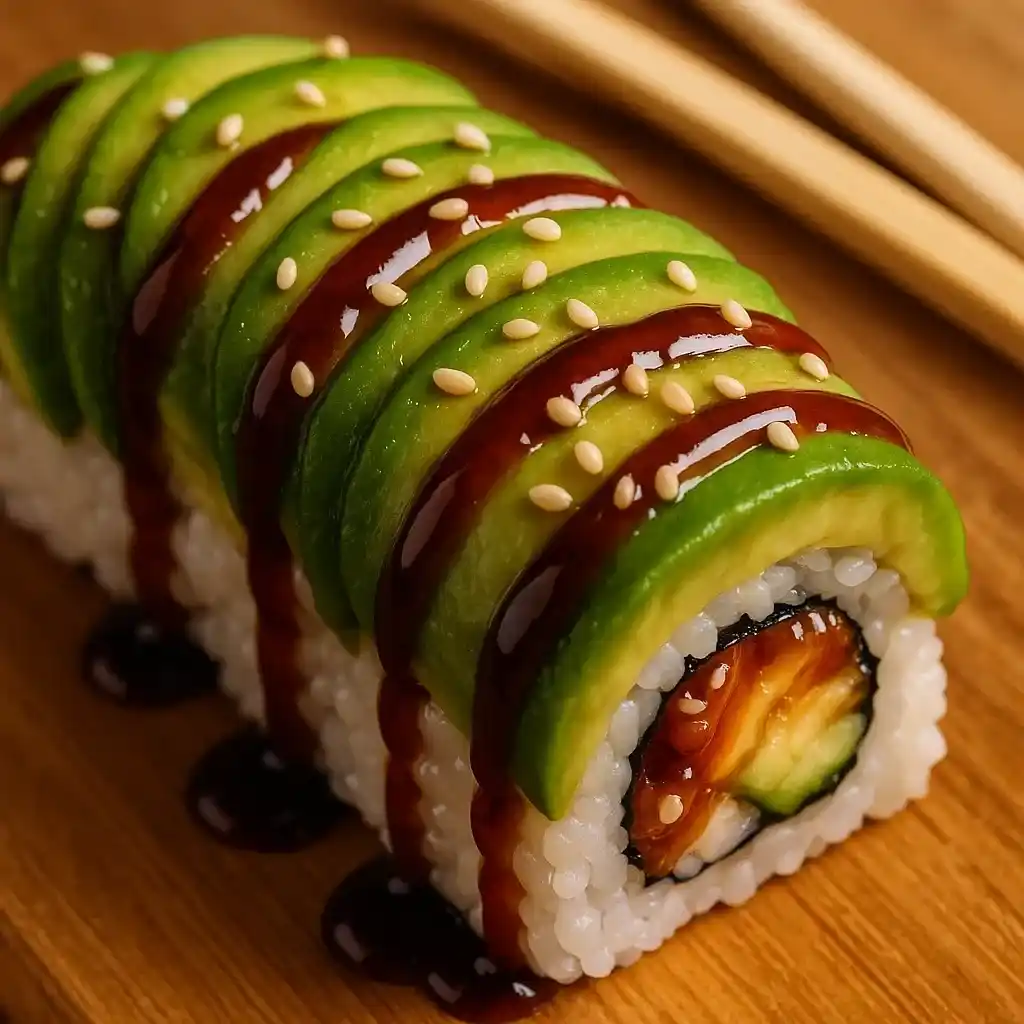
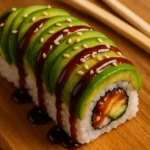
Caterpillar Roll
- Total Time: 30 minutes
- Yield: 4 servings 1x
Description
A homemade Caterpillar Roll sushi with avocado, eel or shrimp tempura, cucumber, and sweet eel sauce – perfect for sushi night at home.
Ingredients
- 2 cups sushi rice
- 3 tbsp rice vinegar
- 1 tbsp sugar
- 1 tsp salt
- 4 sheets nori
- 8 oz cooked eel or shrimp tempura
- 1 cucumber, julienned
- 1 avocado, thinly sliced
- Eel sauce, for drizzle
- Sesame seeds, optional
Instructions
- Cook sushi rice and season with vinegar, sugar, and salt.
- Lay nori on bamboo mat, shiny side down.
- Spread rice evenly, leaving 1 inch at top.
- Add eel or shrimp tempura and cucumber in center.
- Roll tightly using bamboo mat.
- Top with avocado slices.
- Drizzle with eel sauce and sprinkle sesame seeds.
- Slice and serve with wasabi and pickled ginger.
Notes
- Use sushi-grade ingredients for best results.
- Wet your knife before slicing to prevent sticking.
- For a lighter version, use grilled fish or tofu instead of tempura.
- Prep Time: 20 minutes
- Cook Time: 10 minutes
- Category: Dinner
- Method: Rolling
- Cuisine: Japanese
Nutrition
- Serving Size: 1 roll (8 pieces)
- Calories: 320 kcal
- Sugar: 7g
- Sodium: 520mg
- Fat: 12g
- Saturated Fat: 2g
- Unsaturated Fat: 8g
- Carbohydrates: 42g
- Fiber: 4g
- Protein: 14g
- Cholesterol: 45mg
What is a Caterpillar Roll?
Origin and Name
The Caterpillar roll is one of those sushi creations that instantly catches the eye before it even hits your taste buds. Its name comes from the signature avocado topping, sliced so thin and layered so neatly, it resembles the green scales of a caterpillar’s back. While it’s a modern invention—not a traditional Japanese roll—it’s become a staple in sushi restaurants across the United States. Unlike classic nigiri or maki, this roll is all about visual presentation paired with a playful twist on flavor.
Signature Appearance
When you look at a Caterpillar roll, you’ll see an inside-out sushi roll (rice on the outside, nori on the inside) wrapped in overlapping slices of avocado. The roll is often drizzled with rich, glossy eel sauce and sprinkled with sesame seeds, creating a contrast of creamy greens, dark caramel browns, and pale sesame. Many chefs even add cucumber “antennae” or dot the ends with spicy mayo to give it more personality—because food should be fun as well as delicious.
Flavor Profile
This roll is a symphony of textures and flavors. The creamy avocado plays against the chewiness of sushi rice and the slight crispness of cucumber inside. If unagi (freshwater eel) is included, it brings a sweet, smoky, umami depth, balanced by the slightly tangy sushi rice and a touch of sweetness from eel sauce. Whether you’re an adventurous eater or someone just dipping their toes into sushi, the Caterpillar roll is approachable yet satisfying.
Looking for inspiration? Try Ahi Tuna Tostada Recipe for another seafood dish that blends bold flavors with beautiful plating.
Key Ingredients for Caterpillar Roll
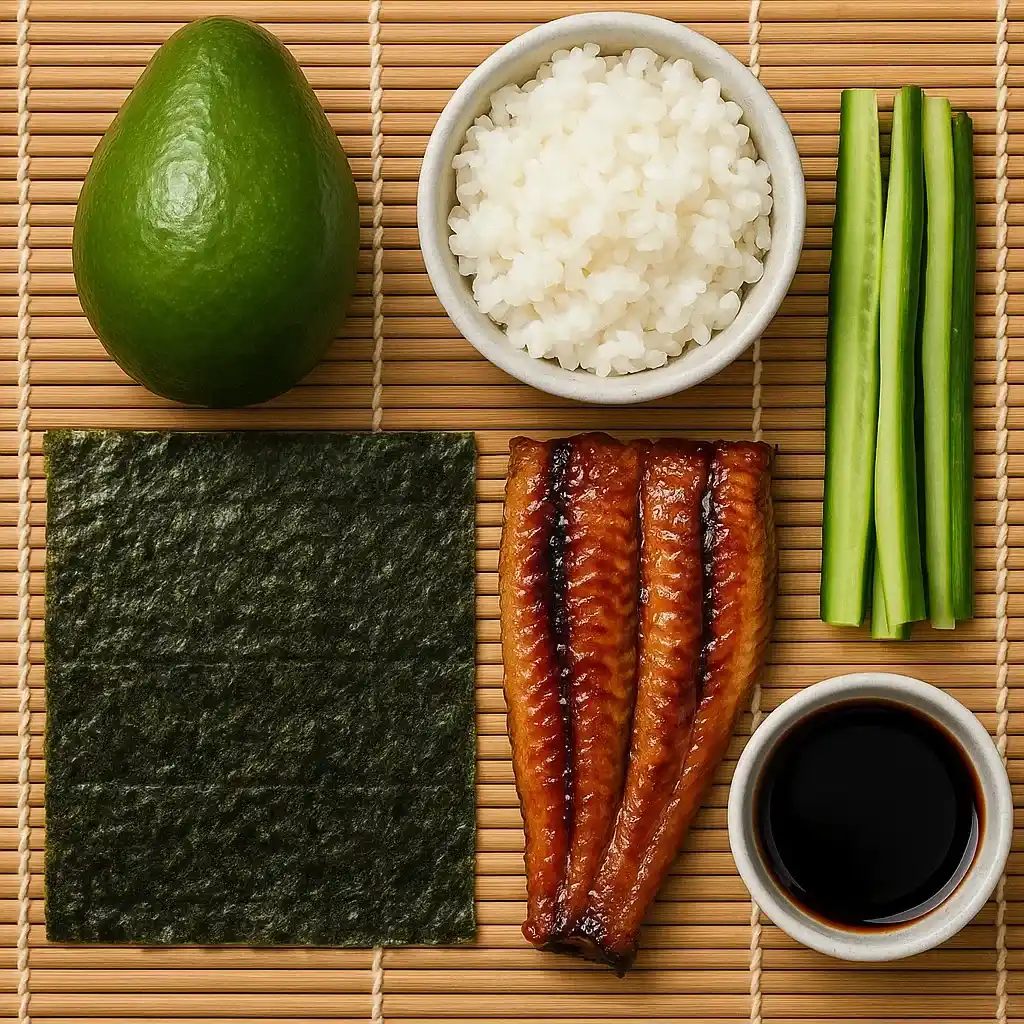
Core Fillings
At the heart of a Caterpillar roll are its fillings, and while there’s room for creativity, the most common choice is unagi (freshwater eel) paired with crisp cucumber. The unagi is usually grilled and brushed with eel sauce, giving it that distinct sweet-savory richness. Some recipes swap in imitation crab or even tempura shrimp for a crunchier bite, making the roll a flexible canvas for your taste preferences. Sushi-grade seafood is always ideal, but since many Caterpillar rolls are made with cooked ingredients, it’s beginner-friendly for home chefs.
Avocado Magic
The star of the show is undeniably the avocado topping. For that smooth, “scale-like” effect, the avocado must be perfectly ripe—not too firm and not too soft. You’ll need to slice it lengthwise into thin, even strips so it drapes over the roll without breaking. Once laid across the sushi, a bamboo mat wrapped in plastic wrap can be used to gently mold the avocado into place, creating that signature caterpillar look.
Sauces and Toppings
A proper Caterpillar roll isn’t complete without the drizzle of eel sauce—a thick, sweet glaze made from soy sauce, sugar, and mirin. Some sushi chefs also add a zigzag of spicy mayo for heat or sprinkle on toasted sesame seeds for texture. Garnishes like thin cucumber curls or tobiko (fish roe) can add a pop of color and crunch.
Don’t miss our Crispy Beef Tacos for another fun, roll-and-fill dish that’s as much about presentation as it is about taste.
Caterpillar Roll vs. Dragon Roll
Ingredient Differences
At first glance, the Caterpillar roll and the Dragon roll look like close cousins—and they are. Both feature avocado draped over the top, but their fillings tell a different story. The Caterpillar roll traditionally has grilled eel and cucumber inside, while the Dragon roll often features tempura shrimp or crab. Dragon rolls can also be more elaborate, sometimes adding extra layers of fish such as tuna or salmon on top.
Visual Style
The Caterpillar roll earns its name because the avocado slices mimic the green segments of a caterpillar. In contrast, the Dragon roll gets its name from a more dramatic presentation—avocado paired with vibrant fish toppings and colorful garnishes that resemble dragon scales. Dragon rolls may be bolder and more flamboyant, while the Caterpillar roll has a cleaner, more minimalist beauty.
When to Choose Which
If you want a lighter, creamy roll that focuses on avocado and cooked eel, the Caterpillar roll is your best pick. It’s perfect for sushi beginners who may be hesitant about raw fish. The Dragon roll, on the other hand, is great for those who like a bit of crunch, variety in toppings, and a mix of raw and cooked seafood. Both are visually stunning, but your choice depends on whether you’re craving something mild and smooth or bold and multi-layered.
Discover great ideas like Elderflower Margarita to pair with sushi night for a refreshing twist.
Does Caterpillar Roll Have Raw Fish?
Traditional Recipe
In its classic form, the Caterpillar roll does not contain raw fish. Instead, it typically uses unagi—grilled freshwater eel—which is fully cooked before it ever meets the sushi mat. This makes it a favorite among sushi newcomers and those who prefer avoiding raw seafood. The cooked eel, paired with fresh cucumber and creamy avocado, creates a rich yet approachable flavor profile.
Modern Variations
While the traditional recipe is raw-fish-free, modern sushi chefs sometimes experiment by adding thin slices of raw tuna or salmon on top for extra color and flavor. These twists can give the roll a touch of freshness and a slight change in texture, appealing to more adventurous sushi fans.
Safe Sushi for Beginners
One of the reasons Caterpillar rolls are so popular—especially in grocery store sushi sections and family-friendly sushi bars—is that they’re low risk. With cooked proteins, you don’t have to worry about the storage and freshness issues that come with raw fish. This makes it an ideal “gateway sushi” for people easing into Japanese cuisine at home.
Check out Cottage Cheese Egg Bake – A High Protein Breakfast for another dish that’s easy, satisfying, and safe for all skill levels in the kitchen.
Step-by-Step Homemade Caterpillar Roll Recipe
Making Sushi Rice
Good sushi starts with great rice. Use short-grain Japanese sushi rice for the right stickiness. Rinse it under cold water until the water runs clear, then cook according to your rice cooker or stovetop instructions. While still warm, gently fold in a mixture of rice vinegar, sugar, and salt. Let it cool to room temperature before rolling—this prevents the avocado from browning too quickly.
Rolling Technique
Lay a bamboo sushi mat on your counter and cover it with plastic wrap to keep it clean. Place a sheet of nori (seaweed) shiny side down. Spread an even layer of sushi rice over the nori, leaving about half an inch at the top edge bare. Flip the sheet so the rice faces down on the mat. Add grilled eel strips and cucumber along the center. Using the bamboo mat, roll it tightly away from you, applying gentle but firm pressure to shape it evenly.
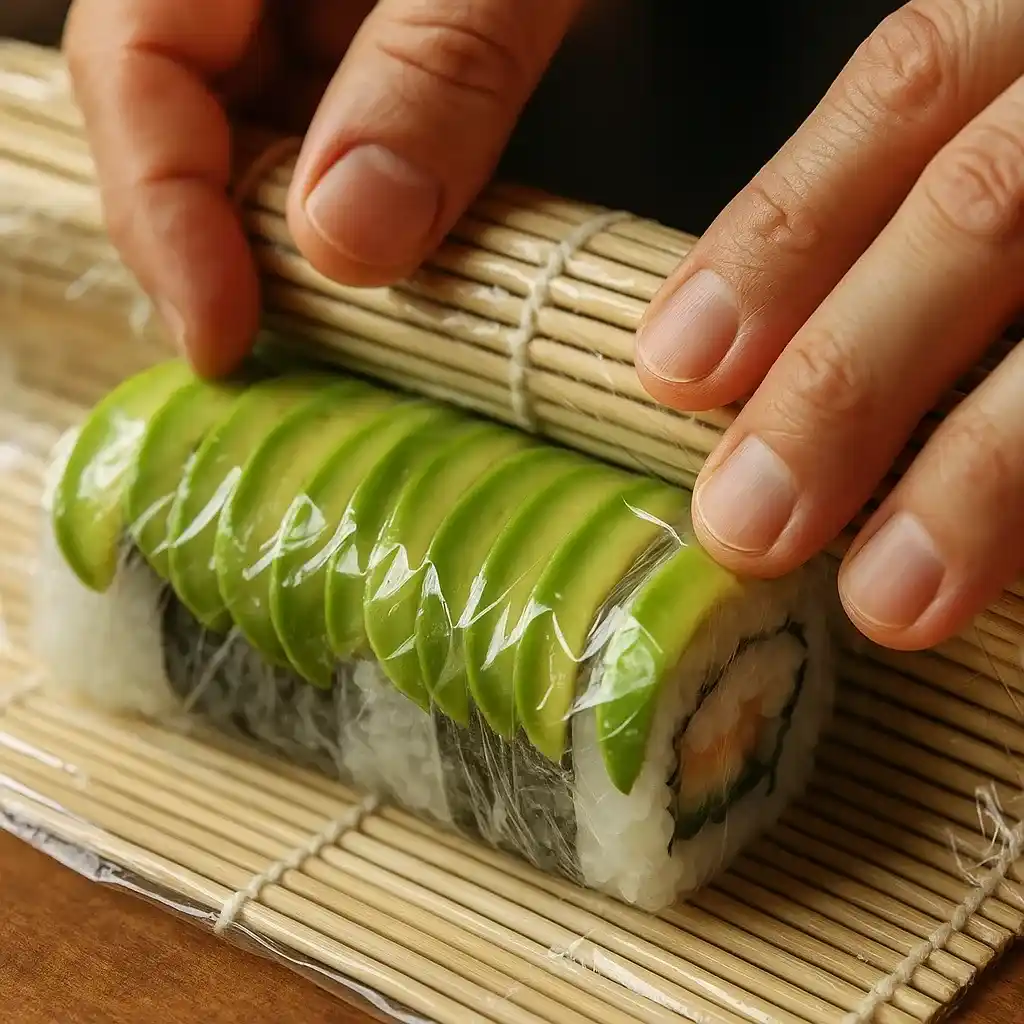
Avocado Layering
For that signature Caterpillar roll look, slice a ripe avocado lengthwise into thin strips. Lay the slices across the top of the roll, overlapping slightly so they resemble scales. Cover with plastic wrap and use the bamboo mat to press lightly, molding the avocado to the roll’s shape.
Finishing Touches
Remove the plastic wrap and drizzle generously with eel sauce. Add sesame seeds, tobiko, or spicy mayo for extra flavor and flair. Slice the roll into even pieces using a sharp, wet knife to prevent sticking. Serve with pickled ginger, wasabi, and soy sauce on the side for the full sushi experience.
Kroger Caterpillar Roll Breakdown
Ingredients Used in Store-Bought Versions
If you’ve ever walked through the sushi section at Kroger, you may have spotted their version of the Caterpillar roll. While presentation varies, it usually includes cooked eel, cucumber, sushi rice, and avocado, topped with a drizzle of eel sauce. Some versions swap eel for imitation crab to make it more budget-friendly. The rice is seasoned but often less vinegary than homemade sushi, and the avocado slices are slightly thicker to hold up in packaging.
Flavor Differences
While Kroger’s Caterpillar roll is convenient, it’s not quite the same as making it fresh at home. The avocado may be a little firmer to withstand storage, and the eel sauce can be sweeter to appeal to a broader audience. Freshly rolled sushi has a softer bite and more vibrant flavor—especially when the rice is still slightly warm and the avocado perfectly ripe.
Nutrition Notes
A standard Kroger Caterpillar roll typically contains around 350–450 calories, depending on portion size. It’s relatively low in saturated fat thanks to the avocado, but sodium levels can be higher due to pre-seasoned rice and sauce. For a lighter version, you can reduce or skip the eel sauce and choose brown sushi rice if available.
Best Side Dishes and Pairings
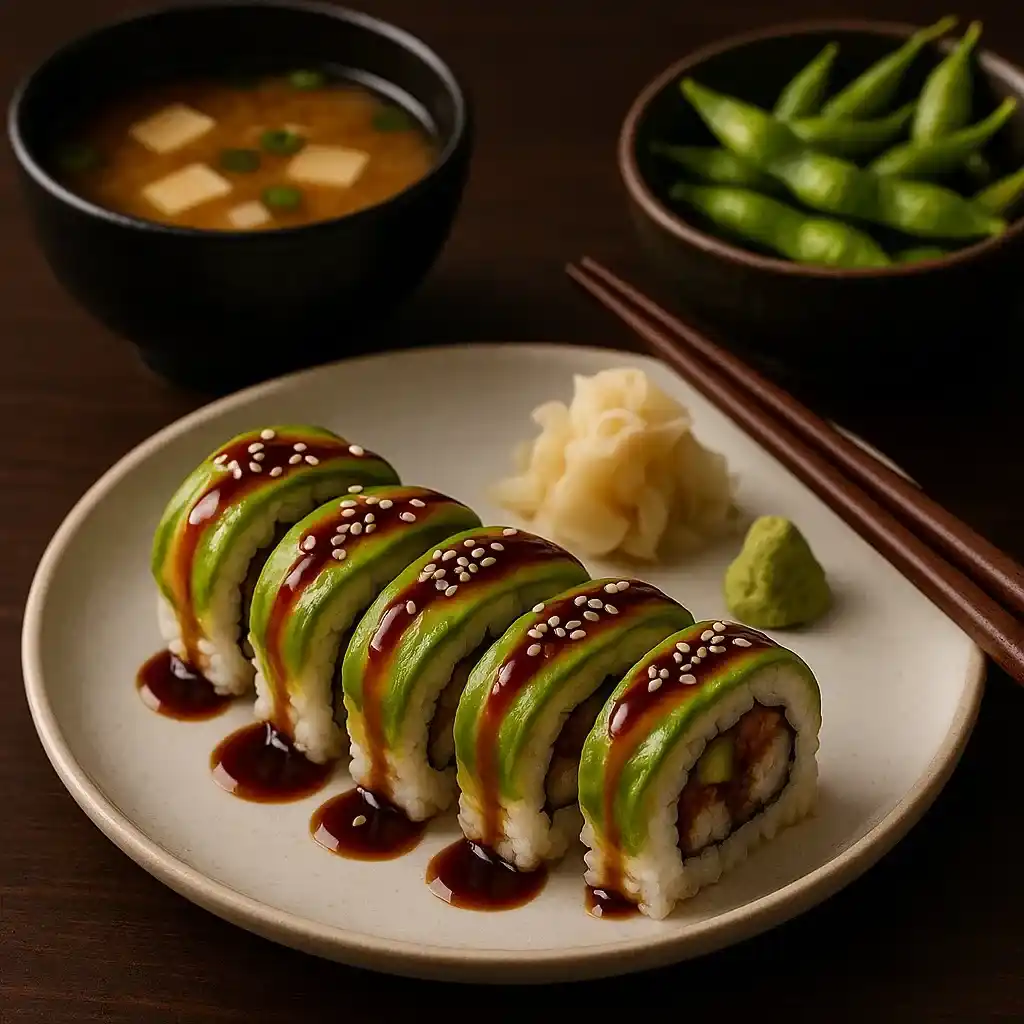
Classic Japanese Sides
To turn your Caterpillar roll into a full meal, start with traditional Japanese accompaniments. Miso soup is a warm, savory opener that pairs perfectly with sushi’s fresh flavors. Edamame, lightly salted and served warm, makes for a healthy, high-protein side. And of course, pickled ginger is essential—not only does it cleanse the palate between bites, but it also adds a bright, tangy contrast to the rich avocado and eel sauce.
Creative Pairings
If you want to put your own spin on sushi night, try adding an Asian-inspired slaw with cabbage, carrots, and a sesame dressing. A mango salad with chili-lime dressing can also balance the roll’s creamy texture with a pop of sweetness and spice. For a fusion touch, pair it with tempura vegetables for that addictive crunch.
Drink Pairings
When it comes to drinks, green tea is the classic choice, helping cleanse the palate without overpowering the sushi’s flavor. If you’re feeling adventurous, sake complements the umami in eel sauce beautifully. For a more modern pairing, a crisp white wine like Sauvignon Blanc or even a refreshing cocktail—like an Elderflower Margarita—can make the meal feel like a special occasion.
Health and Nutrition
Calorie and Macronutrient Breakdown
A standard Caterpillar roll averages between 320–450 calories, depending on portion size and added sauces. Most of those calories come from the rice and avocado, while the eel or alternative protein adds lean protein and omega-3 fatty acids. The roll usually contains about 8–12 grams of protein, 8–15 grams of fat (mostly from heart-healthy avocado), and 40–60 grams of carbohydrates.
Health Benefits
Avocado provides monounsaturated fats, which support heart health and help keep you full. Eel is a good source of vitamin A, vitamin B12, and omega-3 fatty acids, all of which benefit brain and eye health. Sushi rice, when eaten in moderation, provides energy for active lifestyles, while cucumber adds hydration and fiber without many calories.
Dietary Adaptations
For a gluten-free Caterpillar roll, make sure your soy sauce and eel sauce are certified gluten-free. To make it vegetarian, replace eel with grilled shiitake mushrooms or roasted sweet potato for a smoky-sweet bite. You can also make a low-carb version by swapping the rice for cauliflower rice sushi, which keeps the texture but cuts down on carbs.
Conclusion
The Caterpillar Roll is more than a sushi recipe—it’s an opportunity to slow down, gather the people you love, and create something beautiful together. For me, it’s a reminder of my grandmother’s tiny kitchen, where I learned that great food is as much about patience and care as it is about flavor.
From its vibrant avocado topping to the satisfying balance of sweet eel sauce and crisp cucumber, this roll has a way of stealing the spotlight at any table. Whether you follow the classic recipe or put your own twist on it, the joy comes in the process—rolling, slicing, and sharing.
So the next time you’re in the mood for sushi night at home, try making a Caterpillar Roll. You’ll find that the real magic isn’t just in the taste, but in the memories you create while making it.
FAQ – Caterpillar Roll Questions Answered
What is in a Caterpillar Roll sushi?
A traditional Caterpillar roll includes grilled eel, cucumber, sushi rice, and avocado slices layered on top to resemble a caterpillar’s back. It’s usually drizzled with sweet eel sauce and sometimes garnished with sesame seeds or tobiko for extra flavor and texture.
What is the difference between Caterpillar Roll and Dragon Roll?
While both rolls feature avocado on top, the Caterpillar roll focuses on cooked eel and cucumber inside, while the Dragon roll often uses tempura shrimp or crab and may include additional fish or colorful garnishes. The Dragon roll tends to be more elaborate, while the Caterpillar roll has a cleaner, more minimalist look.
Does Caterpillar Roll have raw fish?
Traditionally, no. The Caterpillar roll uses cooked eel, making it a great choice for sushi beginners or anyone who prefers to avoid raw seafood. However, some modern variations may add raw tuna or salmon for extra flavor.
What is in a Kroger Caterpillar Roll?
Kroger’s version typically contains sushi rice, cucumber, avocado, and either eel or imitation crab, topped with eel sauce. The flavor profile is similar to a homemade roll, but the ingredients are adjusted for packaging and storage, meaning the avocado is often firmer and the eel sauce slightly sweeter.
